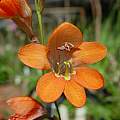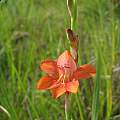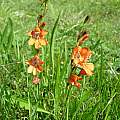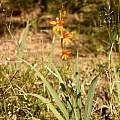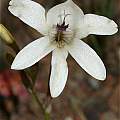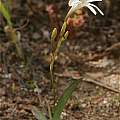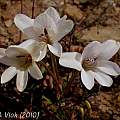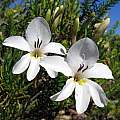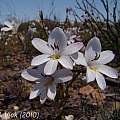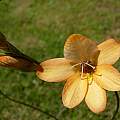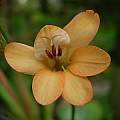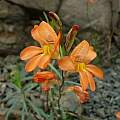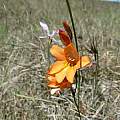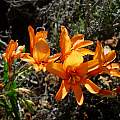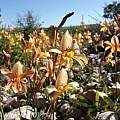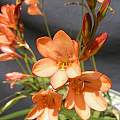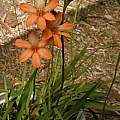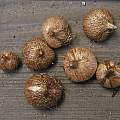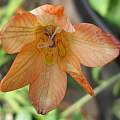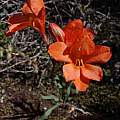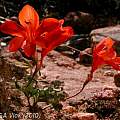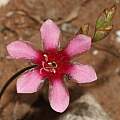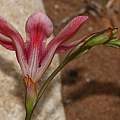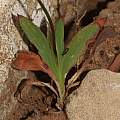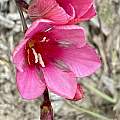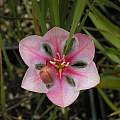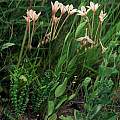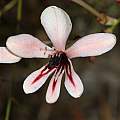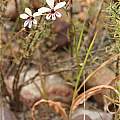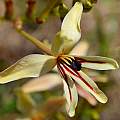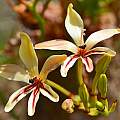Tritonia is a cormous genus in the Iridaceae family from southern Africa. Most of them are in the winter rainfall regions or areas with some rain year round, but there are summer rainfall species too. They occur in a variety of habitats: grassland in summer rainfall areas, renosterveld, karroid scrub, and fynbos in winter rainfall areas. Tritonia species l-u are found on this page.
Tritonia a-d - Tritonia f-k - Tritonia index
Tritonia laxifolia (Klatt) Baker is found on grassy slopes from the Eastern Cape to southern Tanzania. It grows from 20 to 40 cm and has long tubed reddish to orange flowers that face to one side. The lower tepals have a yellow tooth-like callus. It blooms in the fall. It is very similar to Tritonia securigera but flowers at a different time, has smaller flowers and a white throat with slender dark lines. Photos by Cameron McMaster. The first is a close-up that helps show some of the distinctive features of this flower. The last three were taken in habitat in the Eastern Cape.
Tritonia lineata (Salisb.) Ker Gawl. was renamed by Goldblatt and Manning in 2006 to Tritonia gladiolaris
Tritonia pallida Ker Gawl. is found on sandstone and clay slopes in the Little Karoo and coastal areas in the Southern Cape. Growing to 50 cm, it has broad leaves that are sometimes dry at flowering in spring. The creamy white, occasionally pale lilac, flowers have a long tube (up to 65 mm). The first two photos were taken by Andrew Harvie near Barrydale. The last photo from the book Plants of the Klein Karoo courtesy of Jan and Anne Lise Schutte-Vlok.
Tritonia pallida ssp. tayloriae (L.Bolus) M.P.de Vos has a shorter tube and small yellow green teeth in the center of the three lower tepals. The first photo from Rogan Roth who writes: "It grows plentifully in the mountains south of Calitzdorp in the Little Karoo. What I find most interesting about the flower is the prominent yellow crest on each of the lower three tepals." The second photo from the book Plants of the Klein Karoo is courtesy of Jan and Anne Lise Schutte-Vlok.
Tritonia parvula N.E.Br. is closely related to Tritonia securigera and grows in some of the same areas but has a more flaccid habit and the flowers are smaller. Growing 10-25 cm tall, it has reddish to orange flowers. The lower tepals each have a tooth-like yellow callus. It flowers in spring and grows on stony sandstone soils in the Karoo and the Southern Cape to the Eastern Cape area. Photos by Cameron McMaster.
Tritonia securigera (Aiton) Ker Gawl. is another reddish-orange to salmon and sometimes yellow flowered species with many flowers in a spike all facing to one side. It has a yellow throat and large axe-shaped calli on the lower segments (the Latin name means 'carrying an axe'). Height: 15-40 cm. It grows on clay slopes in mixed rainfall areas (the Karoo, coastal Southern Cape to the Eastern Cape). It blooms late spring to early summer. The first three photos were taken by Cameron McMaster. The third photo was taken near Oudtshoorn in the Little Karoo. The fourth photo is from the book Plants of the Klein Karoo courtesy of Jan and Anne Lise Schutte-Vlok.
The first photo by Bob Rutemoeller is of plants grown from seed in California and the next two photos from Mary Sue Ittner show the plants and corms. The last photo by Caroline Langensiepen shows the axe like markings.
Tritonia securigera ssp. watermeyeri (L.Bolus) J.C.Manning & Goldblatt has darker orange flowers and wavy leaves, growing 15-30 cm tall. Photos from the book Plants of the Klein Karoo courtesy of Jan and Anne Lise Schutte-Vlok.
Tritonia squalida (Aiton) Ker Gawl. is very similar to Tritonia crocata but has pink or mauvish pink to almost white flowers with deeper pink veins and claws with hyaline marginal zones. It has almost regular cup-shaped flowers, making it look very different from many other species. The flowers are very beautiful in spite of the ugly species name which refers to the dirty mauve color of herbarium specimens. Height: 25-40 cm. It is found on limestone outcrops and calcareous sands in the Southern Cape. Photos from iNaturalist were taken by Brian du Preez and Christina in September and October in the Western Cape and shared under CC BY-SA and CC BY-NC licenses. The last photo was taken by Mary Sue Ittner and could be a hybrid.
Tritonia undulata (Burm.f.) Baker, syn. Tritonia crispa (L.f.) Ker Gawl., is widespread in the western Cape where it grows on rocky sandstone slopes in fynbos. It has cream to pale yellow or pink long tubed flowers with a red or purple center and red markings. The leaves have undulate and crisped margins. Plants grow 18-35 cm high. It flowers late spring to early summer. Photo 1 from Rod Saunders. Photos 2-3 were taken by Andrew Harvie near Tulbagh. Photos 4-5 by David Retief.
Tritonia a-d - Tritonia f-k - Tritonia index
